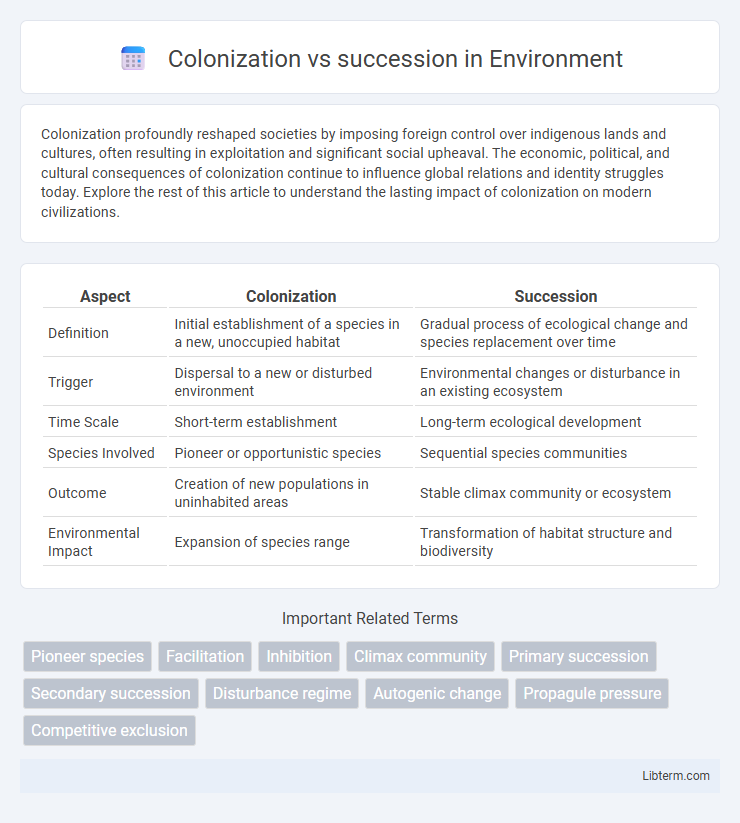Colonization profoundly reshaped societies by imposing foreign control over indigenous lands and cultures, often resulting in exploitation and significant social upheaval. The economic, political, and cultural consequences of colonization continue to influence global relations and identity struggles today. Explore the rest of this article to understand the lasting impact of colonization on modern civilizations.
Table of Comparison
| Aspect | Colonization | Succession |
|---|---|---|
| Definition | Initial establishment of a species in a new, unoccupied habitat | Gradual process of ecological change and species replacement over time |
| Trigger | Dispersal to a new or disturbed environment | Environmental changes or disturbance in an existing ecosystem |
| Time Scale | Short-term establishment | Long-term ecological development |
| Species Involved | Pioneer or opportunistic species | Sequential species communities |
| Outcome | Creation of new populations in uninhabited areas | Stable climax community or ecosystem |
| Environmental Impact | Expansion of species range | Transformation of habitat structure and biodiversity |
Introduction to Colonization and Succession
Colonization refers to the initial establishment of organisms in a new or barren environment, often characterized by pioneer species that adapt to harsh conditions and initiate ecosystem development. Succession is the sequential process by which ecosystems undergo gradual changes in species composition and community structure over time, leading to increased biodiversity and stability. Both colonization and succession play critical roles in ecosystem recovery and habitat formation following disturbances.
Defining Colonization in Ecology
Colonization in ecology refers to the process by which species establish populations in new or previously uninhabited habitats, often involving dispersal and settlement. This phenomenon plays a critical role in ecosystem dynamics by introducing organisms to areas affected by disturbances or newly formed environments. Unlike succession, which describes the gradual, predictable changes in community composition over time, colonization specifically emphasizes the initial arrival and establishment phases of species in an ecological niche.
Understanding Ecological Succession
Ecological succession describes the natural, gradual process by which ecosystems change and develop over time, starting from colonization by pioneer species in disturbed or new habitats. Colonization involves the initial establishment of organisms that modify the environment, paving the way for subsequent species and leading to increased biodiversity and ecosystem complexity. This dynamic transition from colonization to climax community exemplifies succession's role in ecosystem restoration, stability, and resilience.
Key Differences Between Colonization and Succession
Colonization involves the initial establishment of microbial or plant species in a previously uninhabited or disturbed environment, characterized by rapid growth and low species diversity. Succession refers to the gradual process of ecological change where species composition evolves over time, leading to increased biodiversity and ecosystem complexity. Key differences include the temporal scale, with colonization being an immediate response, while succession occurs over extended periods, and the ecological outcome, where colonization initiates community formation and succession drives ecosystem maturation.
Stages of Colonization
Stages of colonization begin with the arrival of pioneer species that establish a foothold in a previously uninhabited or disturbed environment. These organisms modify the habitat, making conditions favorable for intermediate species that increase biodiversity and ecosystem complexity. The final stage leads to a mature, stable community often known as the climax community, characterized by well-established flora and fauna adapted to local conditions.
Stages of Ecological Succession
Ecological succession occurs in stages, beginning with colonization where pioneer species like lichens and mosses establish themselves on bare or disturbed substrates, improving soil conditions. This is followed by intermediate stages featuring grasses, shrubs, and fast-growing trees that gradually modify the habitat, allowing more complex plant and animal communities to develop. The final stage, climax community, represents a stable ecosystem with mature trees and diverse species, reflecting a dynamic equilibrium shaped by ongoing biotic and abiotic interactions.
Factors Influencing Colonization
Factors influencing colonization include the availability of suitable habitats, soil quality, and nutrient availability, which determine the ability of pioneer species to establish. Climate conditions such as temperature, moisture, and light intensity significantly impact the survival rate of colonizing organisms. Dispersal mechanisms and interactions with existing species also play critical roles in shaping initial colonization success and subsequent succession dynamics.
Drivers and Factors of Succession
Succession is primarily driven by changes in environmental conditions, species interactions, and resource availability that collectively facilitate the progressive replacement of species within an ecosystem. Key factors influencing succession include soil development, microclimate stabilization, nutrient cycling, and biotic feedback mechanisms such as facilitation, inhibition, and tolerance among species. Unlike colonization, which depends largely on initial dispersal and establishment abilities, succession emphasizes endogenous ecosystem processes and species adaptations that promote community maturation and increased biodiversity over time.
Real-world Examples: Colonization vs Succession
Colonization refers to the initial establishment of life in previously uninhabited areas, such as microbes colonizing lava flows after volcanic eruptions in Hawaii, while succession involves the gradual replacement and development of ecosystems over time, exemplified by the transition from grasslands to mature forests in the northeastern United States. In real-world contexts, colonization is observed when pioneer species like lichens and mosses invade barren sites, setting the stage for ecological succession that leads to more complex communities. These processes demonstrate dynamic ecosystem recovery and development, with colonization serving as the starting point and succession driving ecological complexity and biodiversity.
Significance and Ecological Impacts
Colonization initiates ecosystem development by introducing pioneer species that stabilize the environment, paving the way for succession, which gradually increases biodiversity and ecosystem complexity. Succession leads to more stable and resilient communities by promoting species interactions, soil formation, and nutrient cycling. Both processes significantly shape habitat structure and influence ecological balance, making them essential for ecosystem recovery and long-term sustainability.
Colonization Infographic

 libterm.com
libterm.com